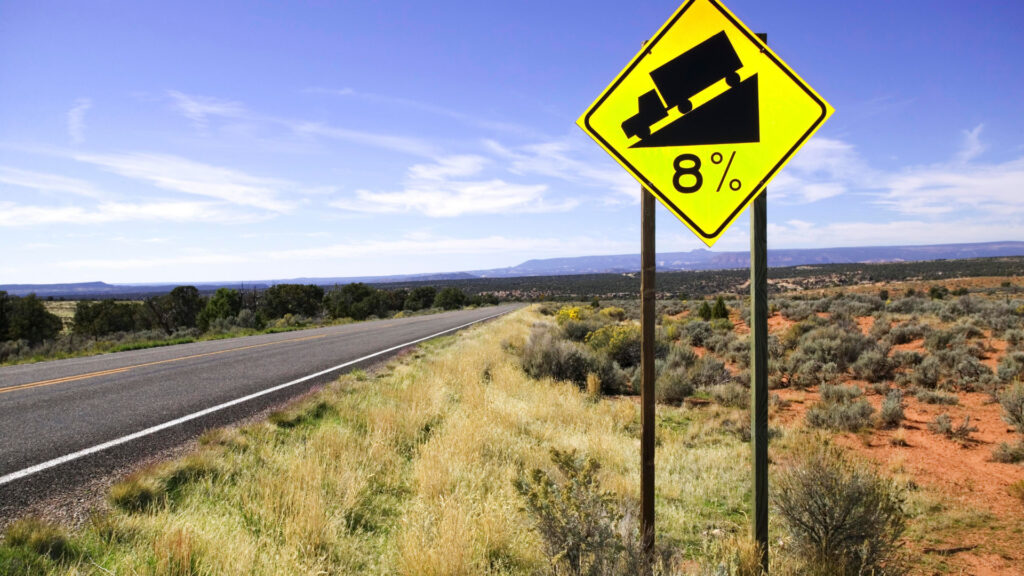Table of Contents Show
Brake fade is the result of overused brakes. As you can imagine, this can lead to potentially dangerous and life-threatening situations.
But as long as you understand how to safely travel through terrain with steep road grades, you don’t have to worry about this.
Driving or towing a heavy, long, and wide RV means being more prepared on a drive day that includes some mountainous climbs.
Let’s learn more!
What Is Road Grade?
Road grade is the amount of gain or drops over a certain distance.
It might also be called the slope, gradient, incline, or decline. A larger number means the road has a steeper tilt compared to a lower number.
For example, a 5% road grade means the road will rise or fall 5 feet over the next 100 feet. A 10% road grade means the road will rise or fall 10 feet over the next 100 feet.
This indicates a steeper incline or decline since you’re traveling the same distance but having a greater change.
What Is the Maximum Grade for a Road?
According to the American Association of State Highway and Transportation Officials’ policy on the geometric design of highways and streets, maximum grades for freeways depend on the terrain and speed limit.
On level terrain with speeds of up to 80 miles per hour, grades shouldn’t exceed 3%, but freeways with speeds of up to 50 miles per hour can have grades up to 4%.
On rolling terrain with speeds of up to 70 miles per hour, grades shouldn’t exceed 4%, but freeways with speeds of up to 50 miles per hour can have grades up to 5%.
Finally, on mountainous terrain with speeds up to 70 MPH, grades shouldn’t exceed 5%, but freeways with speeds of up to 60 miles per hour can have grades up to 6%.
The policy goes on to say, “Grades 1% steeper than the value shown may be provided in mountainous terrain or in urban areas with crucial right-of-way controls.”
Note those are grades for freeways in the United States. Other roads that aren’t federally funded highways can have much steeper grades.
Baldwin Street in Dunedin, New Zealand, is the steepest road in the world, with a 34.8% grade. Canton Avenue in Pittsburgh, Pa., Bradford Street in San Francisco, Calif., and Waipio Valley Road on the Big Island of Hawaii are the steepest streets in the U.S., with grades over 30%.
Why Is Road Grade Important for RVers to Understand?
Because RVs are heavier and longer than standard vehicles, RVers must understand road grades and how to properly drive on steep inclines and declines.
RVers should also learn how and when to change gears, how fast or slow to drive, what gauges to pay attention to, and how and when to apply brakes.
Going up a long, steep road grade in the Rocky Mountains can lead to overheating. Traveling down a long, steep grade can also be dangerous.
Since RVs are heavier, they’ll move faster, potentially leading to an out-of-control situation.
Short, steep grades cause less worry than long grades, even if they’re much less steep. RVs and towing vehicles must work extra hard on long stretches with even the slightest grade.
Tips for When Driving on Roads With Grades
Don’t let grade signs intimidate you. You shouldn’t get nervous when traveling through mountainous regions.
Just know how to operate your RV so you can safely navigate the roads.
Here are a few tips to help you feel confident when you see those percentages.

Observe Speed Limits and Curve Speeds
This is critical to maintaining control of your RV, whether it’s a motorized or towable rig. It’s much better to go too slow than fast when traveling along steep grades.
This is why you’ll see truckers flashing their lights and moving at a snail’s pace in the far right lane in mountainous terrain. This is also why you see runaway truck ramps.
Whatever the speed limit is for the stretch of highway with a steep grade or a curve, you should never go above it.
Losing control of your RV doesn’t just endanger your life but the lives of everyone else traveling along the road.
Pay Attention to Slow-Moving Heavy Vehicles and Overheated Vehicles
As mentioned above, pay attention to truckers moving slowly in the far right lane. Don’t approach them too quickly. You’ll need time to change lanes with an oversized vehicle.
Overheated vehicles also tend to pull over on the side of the road. These vehicles can be standard cars, and they may be on the left or right shoulders of the road. So stay alert.
Keep in Mind: Have you heard horror stories about hitting a pump with your tail end? That’s one of the reasons it’s so important to find an RV Friendly Gas Station!
Monitor Engine and Transmission Temperatures
You’ll see overheated vehicles on the side of the road during stretches of steep road grades because the engine or transmission has gotten hot.
So that you don’t end up being one of those vehicles on the side of the road, it’s essential to monitor your gauges.
Sometimes you’ll even need to switch off your air conditioner to keep your engine cool. Watch your temperature gauge and your transmission temperature gauge if you have one.
If you notice things heating up, back off the throttle and drop down a gear.
Don’t Ride Your Brakes
When maintaining a safe speed, you don’t want to ride your brakes down a slope because this will overheat them. Many truckers will advise aggressive braking instead.
When you’ve reached a safe speed, bear down hard on the brakes to reduce your speed by 5 miles per hour, then release the brake.
If you need to apply the brakes again after reaching a safe speed, do so, but don’t ride them all the way down a steep slope.

Slow Down Before You Reach the Crest and Switch to Lower Gear
Approach the crest of a hill at a lower speed than what you want to be traveling as you start going downhill. Then as the RV speeds up during the descent, you’re not out of control.
You can also approach the crest in a lower gear. You may feel like you’re crawling up the hill in your 40-foot motorhome. But once you start going downhill, you’ll be glad you drove cautiously during the incline.
Listen to Your Vehicle
Finally, listen to your vehicle, whether it’s a motorized RV or a towing vehicle. If you start to hear funny sounds, find a safe place to pull over.
Give your engine, transmission, and brakes a break for a few minutes before continuing on. Enter areas with steep road grades with preparation, but in the end, you have to just pay attention to your vehicle.

Other Possible Dangers When Driving an RV on Steep Grades
In addition to speeds and handling, you also want to look out for other potential dangers when driving on mountainous terrain. Rock falls are common and can happen in an instant.
Wildlife can jump across the road. Most of these roads are narrow with no shoulder, which makes traveling along them in a wider vehicle more stressful.
Weather can also affect your drive. Don’t travel roads with steep grades in poor weather conditions if possible.
Fog can make it dangerous to travel through regions of the country, and ice can easily hide from view on many mountain roads with shadows and dark paved roads.
Keep in Mind: Driving in rough conditions isn’t ideal, especially not in fog. But if you do have to drive in fog, You Should Always Do This!

Understand Road Grade and Be Prepared Your Next Trip
You should always plan your travel day ahead of time. Know where you’re going to stop for fuel, lunch, restroom breaks, and so on. But knowing the terrain of your route is really important, too.
Do a bit of research the night or two before your trip. Check the road grades, how long they last, and where they are so that you feel prepared and can drive confidently, knowing what’s ahead of you.
Don’t avoid visiting Rocky Mountain National Park or other beautiful scenic locations just because of the steep road grades.
Just be prepared and drive cautiously.
Have you ever encountered a steep road grade that made you nervous?







I’ve driven the Moki Dugway in Utah which is an 11% grade on a 3 mile dirt switchback road it was beautiful and I’m glad I did it but once was enough for me